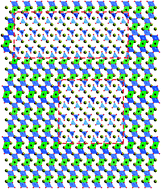The Ba3Mo1−xWxNbO8.5 ion conductors: insights into local coordination from X-ray and neutron total scattering†
Abstract
In the last few years the Ba3Mo1−xWxNbO8.5 system has attracted increasing attention because of its potential application as an electrolyte in solid state fuel cells. The interest in the system arises also from the peculiar migration mechanism, which appears to involve hopping across partially occupied tetrahedral and octahedral sites. However, the reliability of the mechanism is under debate, as a recent single crystal study demonstrated a flaw in the structural model accepted previously, thus hampering the validity of the tetrahedral/octahedral migration mechanism. In order to verify the model, we revised the synchrotron and neutron diffraction data accounting for the correct structure. Neutron powder diffraction data revealed a clear preferential occupation of octahedral sites for the W end member, while synchrotron diffraction confirmed the increase of tetrahedral occupation at high temperature. In addition, we used the pair distribution function (PDF) to resolve the coordination environment based on the characteristic interatomic distances. The neutron PDF provided unambiguous evidence of octahedral sites in W-rich specimens, whose population decreases at high temperature. High resolution synchrotron data revealed a discontinuity with temperature, suggesting a reconstructive phase transition for all the investigated compositions. Synchrotron PDFs suggested structural inhomogeneities at the local scale. The increase of temperature induces a redistribution of O ions at the nm length scale, leading to a disordered structure more favorable for ion migration.



 Please wait while we load your content...
Please wait while we load your content...